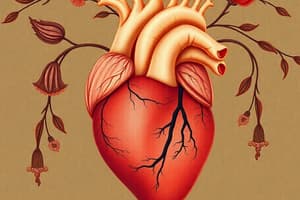Podcast
Questions and Answers
What is the cardiac cycle?
What is the cardiac cycle?
It refers to all events that occur from the beginning of one heartbeat to the beginning of the next.
What is diastole?
What is diastole?
The phase of the heartbeat where the heart ventricles are relaxed and fill with blood.
What is systole?
What is systole?
The phase of the heartbeat where the heart ventricles contract and pump blood into the: aorta (LV) and pulmonary artery (RV).
How do you calculate the cardiac cycle time?
How do you calculate the cardiac cycle time?
If the heart rate is 72 beats per minute, what is the duration of the cardiac cycle including the systole and diastole?
If the heart rate is 72 beats per minute, what is the duration of the cardiac cycle including the systole and diastole?
What are the stages of the cardiac cycle?
What are the stages of the cardiac cycle?
What happens during the filling phase of the cardiac cycle?
What happens during the filling phase of the cardiac cycle?
What happens during the isovolumetric contraction- systole?
What happens during the isovolumetric contraction- systole?
What happens during the outflow phase?
What happens during the outflow phase?
What happens during the isovolumetric diastole?
What happens during the isovolumetric diastole?
What does the S1 sound (lub sound) signify?
What does the S1 sound (lub sound) signify?
What does the S2 sound (dub) signify in the cardiac cycle?
What does the S2 sound (dub) signify in the cardiac cycle?
What is the physiological splitting of the S2 heart sound?
What is the physiological splitting of the S2 heart sound?
What is the S3 sound in the cardiac cycle?
What is the S3 sound in the cardiac cycle?
What is the clinical significance of the S3 sound?
What is the clinical significance of the S3 sound?
What is the clinical significance of the S2 sound?
What is the clinical significance of the S2 sound?
What is the S4 heart sound?
What is the S4 heart sound?
What conditions are the causes for the S4 heart sound?
What conditions are the causes for the S4 heart sound?
What is the point of auscultation of the aortic valve?
What is the point of auscultation of the aortic valve?
What is the point of auscultation of the pulmonary valve?
What is the point of auscultation of the pulmonary valve?
What is the point of auscultation of the tricuspid valve?
What is the point of auscultation of the tricuspid valve?
What is the point of auscultation of the mitral valve?
What is the point of auscultation of the mitral valve?
What is the jugular venous pulse?
What is the jugular venous pulse?
What is the pathway of jugular venous contraction pulsation?
What is the pathway of jugular venous contraction pulsation?
How do you estimate Jugular venous pulse? What does it indicate?
How do you estimate Jugular venous pulse? What does it indicate?
Flashcards are hidden until you start studying



